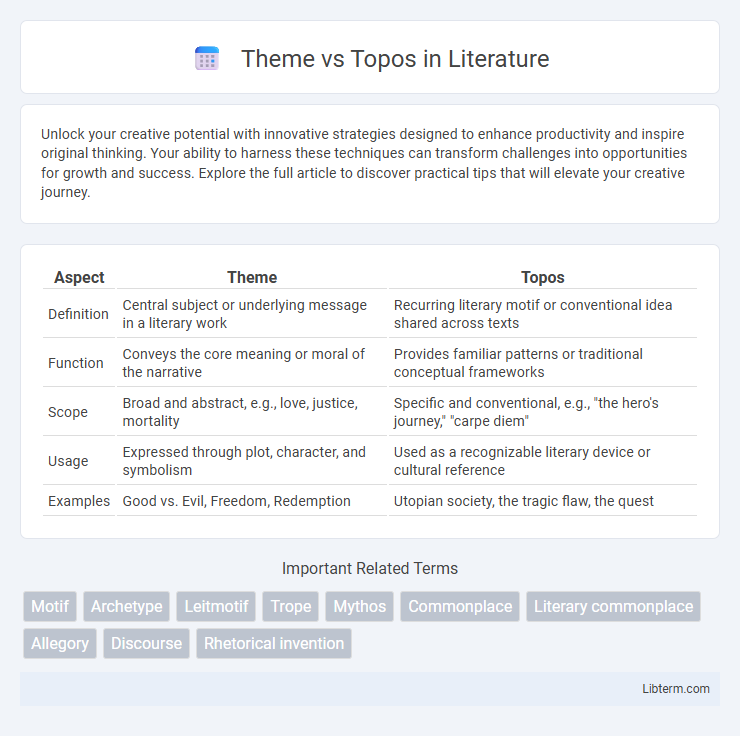Unlock your creative potential with innovative strategies designed to enhance productivity and inspire original thinking. Your ability to harness these techniques can transform challenges into opportunities for growth and success. Explore the full article to discover practical tips that will elevate your creative journey.
Table of Comparison
| Aspect | Theme | Topos |
|---|---|---|
| Definition | Central subject or underlying message in a literary work | Recurring literary motif or conventional idea shared across texts |
| Function | Conveys the core meaning or moral of the narrative | Provides familiar patterns or traditional conceptual frameworks |
| Scope | Broad and abstract, e.g., love, justice, mortality | Specific and conventional, e.g., "the hero's journey," "carpe diem" |
| Usage | Expressed through plot, character, and symbolism | Used as a recognizable literary device or cultural reference |
| Examples | Good vs. Evil, Freedom, Redemption | Utopian society, the tragic flaw, the quest |
Understanding Theme and Topos: Key Concepts
Theme represents the central idea or underlying message in a narrative, reflecting abstract concepts like love, betrayal, or freedom. Topos refers to recurring conventional motifs or commonplaces used to develop themes, such as "the hero's journey" or "forbidden love." Understanding the distinction between theme and topos enhances literary analysis by distinguishing between the core message and the traditional narrative elements that support it.
Historical Origins of Theme and Topos
Themes and topos both originate from ancient rhetorical traditions, where themes served as the underlying subjects or central ideas in literature and speech. Topoi, or commonplaces, emerged from Aristotle's rhetorical framework as standardized argumentative patterns or topics used to develop and organize persuasive discourse. The historical distinction lies in themes representing abstract concepts or motifs, while topoi function as practical heuristic devices guiding reasoning and invention in classical rhetoric.
Defining Theme in Literature
Theme in literature represents the central idea or underlying message explored through a narrative, reflecting universal concepts such as love, power, or identity. It differs from topos, which refers to recurring motifs or conventional literary devices used to convey these ideas. Understanding theme involves analyzing the author's purpose in addressing human experiences and moral questions within the story's context.
Exploring Topos: Classical and Modern Perspectives
Topos, rooted in classical rhetoric as commonplaces or traditional themes, serves as a framework for generating arguments and organizing ideas, distinct from the narrower concept of theme which centers on the subject matter or underlying message in literary works. Modern perspectives expand topos by incorporating interdisciplinary approaches from philosophy, literature, and cultural studies, examining how recurring motifs shape discourse and influence interpretation across diverse texts. Exploring topos involves analyzing its role in structuring narratives and enhancing the persuasiveness and relatability of content through shared societal and rhetorical conventions.
Differences Between Theme and Topos
The theme refers to the central subject or underlying message of a literary work, often reflecting universal ideas or moral questions, while a topos is a conventional motif or recurring literary device used to evoke specific meanings within cultural or rhetorical contexts. Themes provide the broader conceptual framework guiding a narrative's meaning, whereas topos functions as a familiar pattern or cliche that authors deploy to connect with the audience's expectations. Understanding the difference highlights that themes shape the story's purpose, whereas topos enriches storytelling through recognizable symbolic elements.
Functions of Theme and Topos in Narrative Structure
Theme functions as the central idea or underlying message that drives the narrative's meaning and emotional resonance, shaping character motivations and plot development. Topos serves as a conventional motif or recurring narrative pattern that provides familiar frameworks, aiding audience recognition and thematic reinforcement. Together, theme establishes the story's conceptual foundation, while topos offers structural guideposts that enhance coherence and cultural relevance within the narrative.
Examples of Theme vs Topos in Famous Works
In Shakespeare's *Hamlet*, the theme of revenge explores the psychological complexity of vengeance, while the topos of "inevitability of fate" recurs as a cultural motif shaping the narrative's tragic outcome. Dante's *Divine Comedy* presents the theme of spiritual redemption alongside the topos of the journey through the afterlife, reflecting medieval conceptions of morality. In George Orwell's *1984*, the theme of totalitarian control is intertwined with the topos of surveillance, emphasizing societal fears of omnipresent government observation.
The Role of Culture in Shaping Theme and Topos
Culture profoundly influences both theme and topos by shaping the collective values, beliefs, and experiences embedded in narratives. Themes often reflect culturally specific moral lessons or social issues, while topoi serve as recurring cultural motifs or conventional story elements that resonate within a particular cultural context. Understanding culture's role enables deeper analysis of how themes and topoi function as vehicles for expressing and preserving cultural identity in literature.
Analyzing Theme and Topos in Creative Writing
Analyzing theme and topos in creative writing involves identifying the central ideas and recurring motifs that shape a narrative's meaning and structure. Themes represent the underlying messages or moral questions, guiding the emotional and intellectual impact on the reader, while topos refers to conventional literary themes or commonplaces that writers use as recognizable frameworks. A thorough examination of both elements enhances the depth of storytelling, revealing how universal patterns intertwine with unique authorial expression.
Tips for Writers: Balancing Theme and Topos
Writers should carefully balance theme and topos by weaving the universal ideas of the theme with the recognizable, recurring motifs of the topos to create a compelling narrative. Emphasizing clarity in theme helps convey the story's deeper message, while integrating familiar topoi enriches the text with cultural resonance and emotional impact. Maintaining this balance ensures that a story feels both meaningful and relatable, engaging readers on multiple levels.
Theme Infographic

 libterm.com
libterm.com